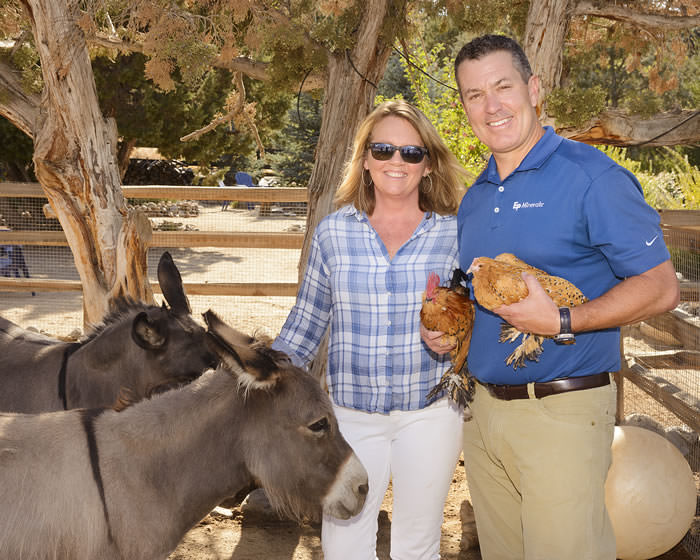edible garden
ON TERRA FIRMA
Gregg Jones of EP Minerals fits a veritable farm on his one-acre lot.
WRITTEN BY CHRISTINA NELLEMANN
PHOTOS BY ASA GILMORE
Gregg Jones’ prolific garden and mini-farm actually began with an overabundance of manure.
His Juniper Hills home in Reno came with a horse, which was then joined by a pair of donkeys named Pumpkin and Pearl. The horse and donkey detritus became the base for his garden’s soil when Jones added red wiggler composting worms to the manure and developed some hearty black gold.
“I had all this good soil and started to think about how could I develop it and create something unique,” Jones says.
Jones is the president and CEO of EP Minerals in Reno and not only uses his garden as a food and gift haven, but also as a laboratory for his company’s products. Much of the food is grown in a 12-by-24-foot hoop house that contains different types of heirloom tomatoes, including brandywine, pineapple, Cherokee, and green zebra. Jones also has been successful in growing cucumbers, peppers, squash, garlic, onions, beets, spinach, and kale. He has struggled with cruciferous vegetables such as broccoli and cauliflower and has not been as successful with corn.
“I give most of the tomatoes away, do some bartering with them, and just have some fun with the overall gardening aspect,” Jones says. “At the same time, I’m always practicing and researching with the products from EP Minerals.”
The good earth
EP Minerals mines and sells diatomaceous earth, perlite, clay, and cellulose to more than 100 countries around the world. Diatomaceous earth is used in everything from paint and plastics to pharmaceuticals, and it is widely used in organic gardening. The absorbent properties of diatomaceous earth will dehydrate and kill harmful insects. Jones uses the earth as a natural insecticide on his tomatoes as well as a bath for his chickens. Adding a layer of the earth to chicken coops and runs is a safe defense against lice and mites; the birds’ instinct to bathe in dirt will spread the white powder over their feathers and onto their skin. Adding diatomaceous earth to a compost pile also will allow the pile’s worms to stay moist.
Feeding his soil is more like an experiment than a recipe. Along with the worm castings from his manure-fed red wigglers, Jones adds the diatomaceous earth for moisture retention, peat moss for organic matter, bone meal, and other micronutrients, and he grows a cover crop, such as beans or barley, that is then rototilled in before the main crop is planted. Jones also adds a dry fungus called mycorrhiza to the soil. Mycorrhizae fungi live in partnership with plants and benefit them by supplying water to the roots and protecting them from fungal diseases and microorganisms. No petroleum-based products or fertilizers come into Jones’ garden.
Jones has had some issues with aphids and whiteflies in the hoop house and has used a mixture of water and diatomaceous earth in a spray bottle to control the pests. For a deterrent, he uses organic neem oil, a vegetable oil made from an evergreen tree, and wants to become more aggressive on the bugs with his homemade compost tea.
“Gardening wasn’t my hobby four or five years ago, but it’s become my hobby since then,” Jones says. “I’m interested in soil science and developing the soil since it’s so rotten here. I like figuring out how to develop soils for the desert and make it unique for growing.”
Local honey
Pumpkin and Pearl share their space with 20 chickens and roosters, dogs Owen and Bodie, and about 500,000 bees. Jones was encouraged to go into beekeeping by a co-worker and now has nine hives.
Jones is a certified producer with the Nevada Department of Agriculture, and he bottles and sells the honey as Pumpkin & Pearl’s Honey Bee Farm at Whispering Vine Wine Co., Eclipse Pizza, and Sports West Athletic Club, all in Reno. In the future, he plans to make mead.
“It’s pretty complex honey and doesn’t taste like something off an alfalfa field; it tastes like a unique bottle of wine and has a structure to it,” Jones says. “It’s all from wild Nevada flowers and trees and the lavender in the garden, and it changes through the seasons.”
However, having bees near the foothills has invited some unwanted guests. Brown bears have attempted to grab Jones’ hives, but he has been successful at deterring them with an electrified poultry net.
“I rarely lose a hive, so I guess what I’m doing is working,” Jones says.
With nutrient-rich soil, fresh vegetables, eggs, and jars of golden honey, production is high on this one-acre hobby farm. So where do the donkeys fit in?
“The donkeys are like big dogs; they just want to be loved on,” Jones says with a laugh. “They just want to follow you around, have you scratch their ears, and sit in your lap. Donkeys are easy, but they just make a lot of noise.”
Christina Nellemann is a writer and gardener living in Washoe Valley and will be using the water and diatomaceous earth spray bottle trick this summer.
Resources
Purchase food-grade diatomaceous earth at the following locations.
Rail City Garden Center
1720 Brierley Way, Sparks • 775-355-1551 • Railcitygardencenter.com
C-A-L Ranch Stores
2035 N. Carson St., Carson City • 775-461-2213 • Calranch.com
C-A-L Ranch carries all three versions of diatomaceous earth: HG (home and garden), LP (livestock and poultry), and AG (agriculture)
For details on EP Minerals, visit Epminerals.com
ProTerra
To make Jones’ insect spray, mix 1 pound of EP Minerals DEsect Diatomaceous Earth Insecticide with 1 gallon of water. Jones puts the spray mix into a one-gallon garden sprayer.
To watch a video about it, visit Plus.google.com/+Epminerals/posts/AtZDpd32vRW


